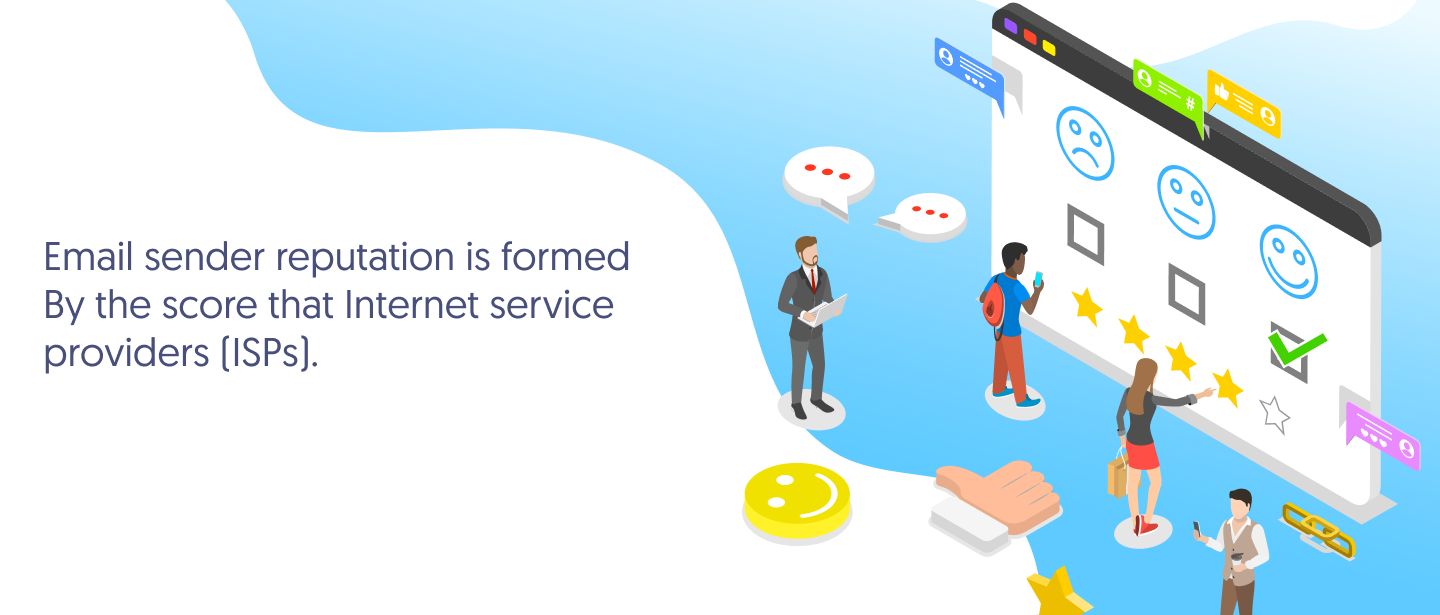Avoid bad email sender reputation & how to check your score
See how to check your email reputation or spam score. Learn how you can maintain a good email reputation and avoid the spam folder in a few easy steps.

Are you a professional who sends out lots of promo or outreach emails? Do you count on leads for signing up for your email list? Perhaps you don’t understand why your email reputation is getting worse, and nobody is actually receiving your newsletters, or more damaging that all your emails are going straight to the spam folder.
This article will show you how to revive your email reputation by following a few simple steps that most professionals are not aware of. Then we will guide you to improve and check your email reputation with the top email reputation services.
Learn how to protect email reputation
Email sender reputation involves both IP and domain reputation. If you do not understand how domains and IPs work, don’t worry! We’ll make everything clear for you.

How do domains & IP addresses work?
Let’s go over some of the basics regarding how domains and IP addresses work. When you understand this, you will know how your emails go from you to your recipients.
How do domains work?
A domain name is what you type into a browser in order to get to your website of choice.
For example, if you wanted to get to WiseStamp, you would usually type in wisestamp.com. Your browser will add the “http” protocol in front of the domain name, and may also add on a “www” record if the domain is set up to include that. Basically, domains are usually easy-to-remember as website addresses people type into google to get to a particular website.

How do IP addresses work?
An IP address is a little more complex and is completely made up of numbers and periods. There are four octets that make sure an IP address.
For example, let’s say the IP address of wisestamp.com is 34.98.121.123. You can have multiple domain names pointing to the same IP address. This is especially common when a web host has potentially thousands of websites being hosted on the same server. That server will contain your website, as well as many others.

Stages of an IP address and how it works
How an email reputation is formed
Let’s go over how email sender reputation is formed. This is the score that Internet Service Providers (ISPs) assign to businesses and organizations that send out emails. You want to make sure your business has a high score. The higher your email sender reputation score, the more likely your emails will be delivered to recipients.
If your email reputation score drops below a certain level, the emails may begin to go into a recipient’s spam folder. In the most extreme cases, the emails will simply be blocked entirely. You definitely want to avoid that happening if you count on your email list for leads and sales.
There are a number of factors that are involved in ISPs deciding what that score is. These usually include:
- How many emails you are sending out
- How many recipients mark your emails as spam
- How frequently your emails drop into ISP spam traps
- Whether your business appears on blacklists
- How many of your emails bounce
- How many recipients are opening, replying to, forwarding, and deleting your emails
- How many recipients are unsubscribing to your email list

As you can see, there are several factors at play when it comes to determining what your email reputation will be. Also, every ISP will determine the reputation differently. Some of the factors listed above will carry more weight than others. That means you could have different reputation scores according to different ISPs.
A good way to increase your domain email reputation is to boost the response time on your emails. When ISPs are considering how to score your email reputation, response time becomes the most heavily weighted factor. That means you will want to ensure you are sending out emails during peak times when your recipients are the most likely to check their email. This is usually in the morning of wherever your recipients are located.
An example of a tactic that leads to a lower domain email reputation is sending out too many emails to your recipients, especially if they lack value. That is one of the quickest ways to incentivize people to mark your emails as spam. Once enough recipients do this, you are going to find it incredibly difficult for your emails to avoid going into spam folders or get blocked entirely.

The importance of good email reputation
When you build up your email reputation, you will get all of your emails to end up in the inboxes of every one of your recipients. This could be the difference between your business thriving and floundering. Today, email is still king when it comes to engagement rates. That is why you want to make sure your email reputation is as high as it can be. Thankfully, there are several ways you can improve your email delivery.
How to improve email reputation the right way
If you are concerned that your domain email reputation may have taken a hit, don’t worry! There are several steps you can take to improve it.
Here are some things you can do:
1) Build up your domain sender reputation:
Domain reputation is a lot like the reputation we develop as people in real life. It is affected by what you have done in the past, as well as who you are associated with. if you are an entrepreneur or small business working with a new domain? If so, you can start out by sending small batches of emails to your most engaged recipients. Remember from before that a high engagement rate will give your domain reputation a significant boost.
2) Double opt-in policy for your IP reputation:
Take advantage of using a double opt-in policy to make sure people receiving your emails really want to get them. When you do this, the people who want to see your emails will receive a confirmation email saying that they signed up. It will also tell them that if they do not want it, or signed up by mistake, they have the chance to unsubscribe.
3) Always filter your email list:
Check up on your email list on a monthly basis. When you do, you should be getting rid of non-responders. This will help prevent your email reputation from dropping due to your emails not being sent to spam folders. It will also prevent high bounce rates. Cleaning up your email lists regularly will help you avoid your reputation from being destroyed.

4) Provide interesting content:
The chances are high that your email recipients are already getting inundated with emails from other companies and sources. That is why you should be delivering meaningful, valuable, and interesting content. This should be a no-brainer but it still has to be mentioned. You should consider lead nurturing campaigns, as well as becoming a pro at email copywriting.
How to check email sender reputation
If you have a suspicion that all of your emails are not getting to the intended recipients, you will want to check on your reputation. If your emails are leading to a lot of people marking them as spam, you may have a problem. Even if your reputation seems to be good, you should periodically check up on it.
Today, there are a number of email reputation services that can help you keep your reputation high, or assist you in boosting it. Here are some of the best ones available today to monitor your email sender reputation. Knowing what the state of your reputation is can help you take the appropriate measures.
Top email reputation services
Since every ISP measures email reputation in its own way, there is no single score that you can look up. Some ISPs are also using third-party tools that do all of the work for them. Every ISP and tool out there is basing its score on a different data source. That is why a single score can never provide the full story of what is going on with someone’s email reputation.
When multiple scores are looked at, you can identify issues that may be hampering your reputation. Some of the best tools and email reputation services that can perform a diagnosis of your email reputation are the following:
1) Microsoft email reputation check
This tool provides a service that is called Smart Network Data Services. Its intention is to assist web hosts and ISPs to detect whether there is spam being sent to email recipients. Compromised servers, malware, viruses, and botnets are what this tool focuses on finding.
The data that this email reputation provides includes information like the reputation of your email server’s IP, the number of Microsoft spam traps your emails are going to, and what your spam complaint rate is.

2) SendGrid email reputation
SendGrid is an email reputation service that is used by developers and marketers that can handle scaling. It also provides a way to check your email reputation. The score it spits out will be anywhere between 0% and 100%. Depending on how high your bounce rate is, how many recipients block you, and how many recipients mark your emails as spam, the score will go higher or lower.
The reputation score is based on calculating bounce rates, unsubscribes, invalid emails, and spam reports. When your reputation stays above 80%, you are considered to have a good reputation. When it falls to somewhere between 70% and 80%, you are considered to have a poor reputation and should take action right away. If your reputation drops below 70%, you may find yourself without the ability to send emails to anyone.

3) SenderScore
SenderScore has designed its reputation score system similar to how a credit score is calculated. This email reputation service will rank somewhere in the range between 0 and 100. The higher your Sender Score, the better your reputation. This means you will have a higher email deliverability rate as well.
Your Sender Score gets calculated according to a 30-day rolling average. This tool also takes into account how the IP address you are sending emails from is ranking compared to other IP addresses. As with SendGrid, if you’re reputation scores above 80%, you’re in the clear. If it drops down to somewhere between 70% and 80%, you should improve your score. When it goes lower than 70%, you need to do some major reputation repair.
4) BarracudaCentral
Barracuda Networks provides an IP and domain reputation tool that is a part of the Barracuda Reputation System. This includes a real-time database containing IP addresses that have been marked as having either “poor” or “good” reputations. Basically, if you have a history of spamming or are someone who has always followed the rules, you will be placed into one of these two categories.
The Barracuda Reputation System is tied into the Barracuda Spam & Virus Firewall and informs it whether to block or allow messages. If your IP address is on the good list, your email gets to go through to the recipient. If it’s not, it simply won’t. Barracuda’s system also applies the same process to domains as well. This ensures that only emails coming from IPs and domains that are in good standing can move onward to their intended recipients. This company claims it has a 95% spam accuracy rate
Wrap Up
When you follow these simple steps, you will improve your domain reputation in no time! If you want to boost your email engagement rates and reputation even more, make sure you add an email signature. Even better, have it include a button that allows people to easily subscribe to your newsletter. Enjoy your higher email reputation!

